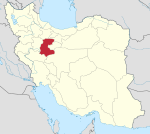Saveh
Saveh
ساوه | |
|---|---|
city | |
 Sardaran square | |
| Country | |
| Province | Markazi |
| County | Saveh |
| Bakhsh | Central |
| Elevation | 1,008 m (3,307 ft) |
| Population (2011) | |
| • Total | 259,030 |
| Time zone | UTC+3:30 (IRST) |
| • Summer (DST) | UTC+4:30 (IRDT) |
| Website | www www |
Sāveh (Template:Lang-fa, also transliterated as Sāva)[1] is a city in the Markazi Province of Iran. It is located about 100 km southwest of Tehran.[2][3] As of 2011, the city had a population of 259,030 people.[4]
History
In the 7th century BC it was a stronghold of the Medes. During the Parthian rule of Persia, it was called Saavakineh, and was one of the main hubs of the empire.
In the Middle Ages, it was a residence of the Dailamites and of the Seljuqs. It was severely damaged by the Mongol invasion in the 13th century; it was restored during the Ilkhanids. Saveh was again sacked by the Timurids, but later grew under the Safavids. It eventually lost much of its importance when Tehran became the official capital of Persia and, in the mid-19th century, many of the inhabitants moved to Tehran.
Climate
Saveh has a cold semi-arid climate (BSk) in Köppen-Geiger classification system.[5] Its summers are very hot and dry, while its winters are mild and somewhat rainy.
| Climate data for Saveh | |||||||||||||
|---|---|---|---|---|---|---|---|---|---|---|---|---|---|
| Month | Jan | Feb | Mar | Apr | May | Jun | Jul | Aug | Sep | Oct | Nov | Dec | Year |
| Mean daily maximum °C (°F) | 7.6 (45.7) |
10.1 (50.2) |
16.2 (61.2) |
22 (72) |
29 (84) |
34.5 (94.1) |
37.4 (99.3) |
36.8 (98.2) |
32 (90) |
26 (79) |
17.7 (63.9) |
12.2 (54.0) |
23.5 (74.3) |
| Daily mean °C (°F) | 2.4 (36.3) |
4.5 (40.1) |
10.2 (50.4) |
15.4 (59.7) |
21.2 (70.2) |
26.2 (79.2) |
29.2 (84.6) |
28.5 (83.3) |
23.7 (74.7) |
18.8 (65.8) |
11.6 (52.9) |
6.9 (44.4) |
16.6 (61.8) |
| Mean daily minimum °C (°F) | −2.7 (27.1) |
−1 (30) |
4.3 (39.7) |
8.8 (47.8) |
13.5 (56.3) |
18 (64) |
21.1 (70.0) |
20.3 (68.5) |
15.4 (59.7) |
11.6 (52.9) |
5.6 (42.1) |
1.6 (34.9) |
9.7 (49.4) |
| Average precipitation mm (inches) | 37 (1.5) |
26 (1.0) |
34 (1.3) |
30 (1.2) |
16 (0.6) |
4 (0.2) |
1 (0.0) |
1 (0.0) |
3 (0.1) |
13 (0.5) |
28 (1.1) |
30 (1.2) |
223 (8.7) |
| Source: Climate-Data.org, altitude: 1002m[5] | |||||||||||||
Main sights
- Jameh Mosque of Saveh, built by the Seljuks during the 11th century. It includes a courtyard, porch, a 14 m tall minaret, nocturnal areas, a tiled dome (14 m tall, with a diameter of 16 m) and two altars with inscription in Kufic script.
- Red Mosque of Saveh, also known as Enqelab Mosque. Dating to the Seljuk-era, it has a brickwork dome, an 11th-century minaret, three porticoes, and internally houses an altar with plasterwork and inscriptions.
- Imamzadeh Soltan Seyed Eshaq Mausoleum
- Sorkhdeh Bridge, south of the city
- Khamseh-Abad caravansarai
Outside the city are the fortresses of Esmaeilieh (35 km), Alvir and Ardemin (56 km, on the road to Hamadan), as well as the archaeological sites of Aveh and Alishar.
Economy
Saveh produces large amounts of wheat and cotton. It is also well known for its pomegranates and melons.[6] Kaveh Industrial City, the largest industrial city in Iran, is located in Saveh.
Legends
According to Iranian tradition, the Magi who visited the infant Jesus traveled from Saveh, and are buried among its ruins. Marco Polo described the tombs of the Magi in his travel book, Il Milione:
In Persia is the city of Saba, from which the Three Magi set out... and in this city they are buried, in three very large and beautiful monuments, side by side. And above them there is a square building, beautifully kept. The bodies are still entire, with hair and beard remaining. (Book i).[7]
Saveh is said to have possessed one of the greatest libraries in the Middle East, until its destruction by the Mongols during their first invasion of Iran.[7]
Another legend about Saveh is the Lake of Saveh. It is a lake which is said to have been located near the city. According to the legend mentioned in historical Persian texts, this lake dried out on the night of the birth of Muhammad. A recent investigation in the Zarand area between Tehran and Saveh has revealed some evidence of the existence of this lake in Zarand Plain.[8]
Politics
In 2004, Saveh became only the second city in the history of the Islamic Republic to appoint a woman as mayor.[3]
People
- Yusuf Adil Shah (former Mamluk and founder of the Bijapur Sultanate)
References
- ^ Saveh can be found at GEOnet Names Server, at this link, by opening the Advanced Search box, entering "-3083174" in the "Unique Feature Id" form, and clicking on "Search Database".
- ^ "Savah". 1911 Encyclopædia Britannica.
- ^ a b "Iran's only female mayor sweeps up small town". The Daily Star. August 4, 2004.
- ^ Statistical Center of Iran: 2011 Iranian Population and Housing Census
- ^ a b "Climate: Saveh - Climate graph, Temperature graph, Climate table". Climate-Data.org. Retrieved 30 August 2013.
- ^ Cohen, Saul (1998). The Columbia Gazetteer of the World. Columbia University Press. p. 2833.
- ^ a b Polo, Marco and Rustichello da Pisa (1903). Henry Yule and Henri Cordier (ed.). The Travels of Marco Polo: The Complete Yule-Cordier Edition.
- ^ Okhravi, R. and Djamali, M. (2003). "The missing ancient lake of Saveh: a historical review". Iranica Antiqua, 38, 327-344.

